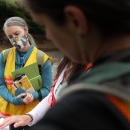The purpose of the Endangered Species Act (ESA) is to provide a means to conserve the ecosystems upon which endangered and threatened species depend and provide a program for the conservation of such species. The ESA directs all federal agencies to participate in conserving these species. Specifically, section 7(a)(1) of the ESA charges federal agencies to aid in the conservation of listed species, and section 7(a)(2) requires the agencies to ensure their activities are not likely to jeopardize the continued existence of federally listed species or destroy or adversely modify designated critical habitat.
What is a Section 7 Consultation?
The provision under Section 7 Section 7
Section 7 Consultation
The Endangered Species Act (ESA) directs all Federal agencies to work to conserve endangered and threatened species and to use their authorities to further the purposes of the Act. Section 7 of the Act, called "Interagency Cooperation," is the mechanism by which Federal agencies ensure the actions they take, including those they fund or authorize, do not jeopardize the existence of any listed species.
Learn more about Section 7 that is most often associated with the Service and other Federal agencies is section 7(a)(2). It requires Federal agencies to consult with the Service to ensure that actions they fund, authorize, permit, or otherwise carry out will not jeopardize the continued existence of any listed species or adversely modify designated critical habitats.
Who Needs It?
Federal agencies must consult with the U.S. Fish and Wildlife Service (Service) when any project or action they authorize, fund, or carry out may affect a listed species or designated critical habitat. The consultation process can vary depending on the complexity of the project or action.
Service staff works with federal action agencies to develop the documentation needed to initiate and complete consultation. We strongly encourage federal agencies to contact the appropriate Ecological Services Field Office well in advance of proposed projects or actions. Doing so allows all parties to better understand the proposed project or action and gather the information needed to complete the consultation in a timely manner.
Consultation Process
Step 1 - Informal Consultation
The consultation process usually begins as informal consultation. The federal agency must initiate consultation when any action they authorize, fund, or carry out (such as through a permit) may affect a listed endangered or threatened species or designated critical habitat.
Step 2 - Review
In the early stages of project planning, federal agencies can request technical assistance from the appropriate Service field office. Discussions between the two agencies may include what types of listed species may be present in the proposed action area action area
All areas to be affected directly or indirectly by the federal action and not merely the immediate area involved in the action.
Learn more about action area , and what effect the proposed action may have on those species. Agencies may use the Service's digital project planning tool, Information for Planning and Consultation, to get a list of species and critical habitats that may be present in the action area.
Step 3 - Determination
If the federal agency determines, through a biological assessment or other review, that its action is likely to adversely affect a listed species, the agency submits to the Service a request for formal consultation.
Agencies may use the Service's digital consultation package builder tool, available on IPaC, to assist in developing a biological assessment or evaluation.
Step 4 - Formal Consultation (If Applicable)
During formal consultation, the Service and the agency share information about the proposed project and the species or critical habitat likely to be affected. Formal consultation may last up to 90 days, after which the Service will prepare a biological opinion. The intent of a biological opinion is to analyze the effects of the proposed action to the listed species or designated critical habitat.
Step 5 - Conclusion of Biological Opinion
The conclusion of the biological opinion will state whether the federal agency has ensured that its action is not likely to jeopardize the continued existence of a listed species and/or result in the destruction or adverse modification of critical habitat. A biological opinion usually includes conservation recommendations to further the recovery of listed species, and it also may include reasonable and prudent measures, as needed, to minimize any "take" of listed species.
The Service has 45 days after completion of formal consultation to write the biological opinion.
Get Started
Federal agencies wishing to explore beginning a Section 7 Section 7
Section 7 Consultation
The Endangered Species Act (ESA) directs all Federal agencies to work to conserve endangered and threatened species and to use their authorities to further the purposes of the Act. Section 7 of the Act, called "Interagency Cooperation," is the mechanism by which Federal agencies ensure the actions they take, including those they fund or authorize, do not jeopardize the existence of any listed species.
Learn more about Section 7 consultation should consult the Ecological Services office nearest the proposed project site. See our "Find a facility" map to locate the nearest office.

